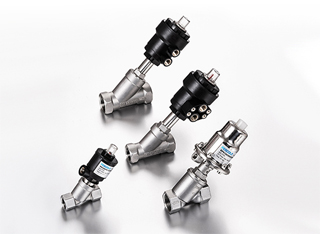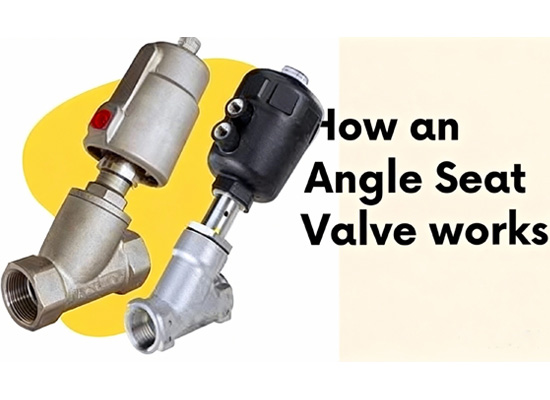
Angle seat valves are a type of valve used in fluid control systems, typically found in applications where precise regulation of the flow of liquids or gases is required. They are commonly used in industries like food processing, pharmaceuticals, chemical engineering, and water treatment.
Angle seat valve is a standard automated pneumatic component, it does not require additional actuators and is an integrated piston-type pneumatic actuated valve. The type driven by compressed air to control the valve opening and closing through piston movement is the most common.
Due to the angled design of the valve seat, fluid flow resistance is minimized, resulting in maximum flow rate and minimal pressure loss. These valves are used to regulate the flow of liquids, gases, steam, vacuum, and even corrosive media. Angle seat valves can operate under high temperatures and with high-viscosity media even at zero differential pressure. Air operated angle seat valve is a kind of automatical operation method.Its piston is the main drive component that actuates the valve stem in angle seat valve.
Pneumatic angle seat piston valve with high flow capacity and fast response are suitable for industries such as chemical, food and beverage, and pharmaceutical and biotechnology.Moreover,their robust design makes them suitable for demanding environments and ensures a long service life.

Angle Design:
The name "angle seat" comes from the valve's design, where the inlet and outlet ports are positioned at a 90-degree angle to each other.This angle helps to provide a compact design and allows for smoother flow.
Seat and Seal:
Angle seat valves usually have a "seat" that provides a tight seal when the valve is closed. The seat is typically made from durable materials like stainless steel, which helps ensure a long lifespan and resistance to corrosion.
Valve Actuation:
These valves can be actuated pneumatically means using compressor air as energy.The pisotn of air operated actuator controls the position of the valve core, regulating the flow of the medium through the valve.
Flow Control:
The material of angle seat valve designed for high-flow applications and are often used to control liquids or gases at high pressures.
Quick Response:The pneumatic actuator uses compressed air to drive the piston, which in turn moves the valve stem in rapid reciprocating motion, greatly increasing the opening and closing speed of the angle seat valve.
Compact Design: The 45-degree angle design saves space, especially in tight installations.
Durable: Made of stainless steel and other high-strength materials, they are resistant to corrosion and wear.
Easy Maintenance: Angle seat valves are generally easy to disassemble for cleaning or maintenance, particularly in sanitary applications.
But angle seat valve also has disadvantages that requires an external supply of compressed air and periodic maintenance and replacement of the piston and other driving components.
Structure:
Standard angle seat design, with the valve stem and seat at a certain angle, resulting in low fluid flow resistance. Driven by a cylinder, the valve stem has a spring reset structure.
Features:
Universal structure that can use various fluid media including water, steam, and air. The material has high corrosion resistance and is usually equipped with stainless steel valve bodies and stems. The valve seat is well sealed and suitable for frequent opening and closing.
Structure:
Compared to the PV series, the valve stem and sealing structure have been optimized to reduce wear and leakage.
Features:
This series places greater emphasis on energy conservation, environmental protection, and efficiency. Suitable for situations that require quick response and high-frequency operation. Multiple fluid media can also be used.
Structure:
The valve body structure is sturdy and has high temperature resistance characteristics.
Features:
Suitable for steam and high-temperature fluid control.
High temperature alloy or special stainless steel material
Excellent sealing performance, suitable for high-pressure environments.
Structure:
Compact design with high integration of cylinder and valve body. Structural integration reduces the number of parts.
Features:
Compact in size and lightweight, suitable for occasions with limited space.
Mainly used for controlling medium and low pressure fluids.
Flexible operation and simple maintenance.
Rapid Shut-Off and On-Off Operation
High Flow Capacity
Reliable Sealing and Safety
Durability & Long Service Life
Rapid Response & High-Frequency Cycling
Pneumatic actuator has a piston that moves the valve stem up and down within the valve body to open or close the valve. When the valve is in the "open" position, the fluid or gas can flow through the valve;When the valve is closed, the valve core presses against the seat, sealing the valve and stopping the flow.
Angle seat valves are especially effective for applications where high flow rates needed, such as in steam, air, or water systems. They are often used in systems requiring automatic flow regulation or in combination with sensors and controllers.
You can browse this article for more specific details about the operation.If you want to learn more details about angle seat valves, feel free to visit our subsite: https://www.fokcavalve.com/
The valve seat angle is the angle between the sealing surface of the seat and the pipeline centerline (commonly 45° or 30°). This angle determines the contact pattern between the disc and the seat, influencing sealing performance, flow capacity, and operating force.
Angle seat valves are primarily used for on/off control. They are suitable for applications involving high frequency, high flow rates, and media containing particles or high viscosity. They are often paired with pneumatic or electric actuators to achieve rapid opening and closing.
The angle can be checked by directly measuring it with a protractor or valve seat angle gauge, inspecting the contact pattern on the sealing surface using the Prussian blue/red lead method, or indirectly verifying it through flow or leakage tests.
Links: www.fescolo.com(Pneumatic)
FOKCA ©1998-2025 All Rights Reserved Sitemap